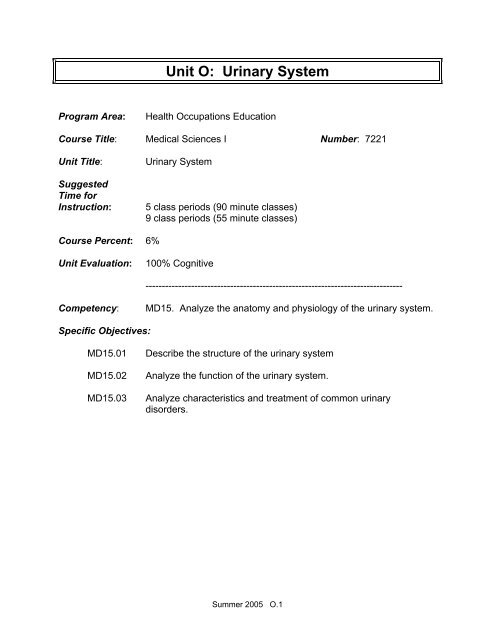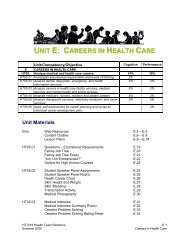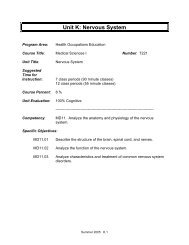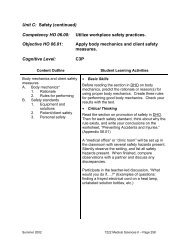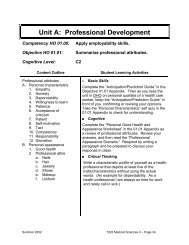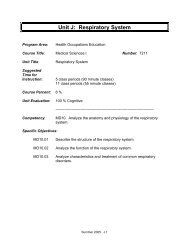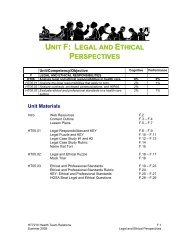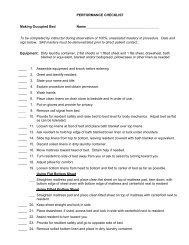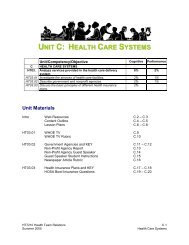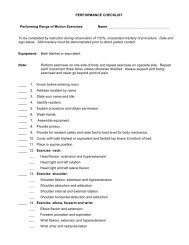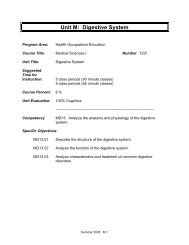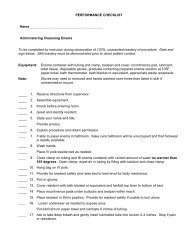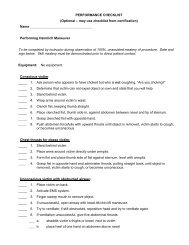Unit O: Urinary System - Mitchell High School
Unit O: Urinary System - Mitchell High School
Unit O: Urinary System - Mitchell High School
Create successful ePaper yourself
Turn your PDF publications into a flip-book with our unique Google optimized e-Paper software.
<strong>Unit</strong> O: <strong>Urinary</strong> <strong>System</strong><br />
Program Area: Health Occupations Education<br />
Course Title: Medical Sciences I Number: 7221<br />
<strong>Unit</strong> Title: <strong>Urinary</strong> <strong>System</strong><br />
Suggested<br />
Time for<br />
Instruction: 5 class periods (90 minute classes)<br />
9 class periods (55 minute classes)<br />
Course Percent: 6%<br />
<strong>Unit</strong> Evaluation: 100% Cognitive<br />
-------------------------------------------------------------------------------<br />
Competency: MD15. Analyze the anatomy and physiology of the urinary system.<br />
Specific Objectives:<br />
MD15.01 Describe the structure of the urinary system<br />
MD15.02 Analyze the function of the urinary system.<br />
MD15.03 Analyze characteristics and treatment of common urinary<br />
disorders.<br />
Summer 2005 O.1
O. <strong>Urinary</strong> <strong>System</strong><br />
<strong>Unit</strong> O: Master Outline<br />
MD15.01 Describe the structure of the urinary system<br />
A. Kidney<br />
1. Bean-shaped<br />
2. Located between peritoneum and the back muscles (retroperitoneal)<br />
3. Renal pelvis – funnel-shaped structure at the beginning of the ureter<br />
4. Medulla<br />
a, Inner, striated layer<br />
b. Striated cones are renal pyramids<br />
c. Base of pyramids empty into cuplike cavities called calyces<br />
5. Cortex – composed of millions of microscopic nephrons<br />
B. Nephron – functional unit of kidney<br />
1. Bowman’s capsule<br />
2. Glomerulus<br />
3. Proximal convoluted tubule<br />
4. Loop of Henle<br />
5. Distal convoluted tubule<br />
6. Collecting tubule<br />
C. Ureters<br />
1. One from each kidney<br />
2. Smooth muscle tube with mucous membrane lining<br />
D. <strong>Urinary</strong> bladder<br />
1. Hollow, muscular organ<br />
2. Made of elastic fibers and involuntary muscle<br />
3. Stores urine – about 500 cc<br />
E. Urethra<br />
1. Connects bladder with urinary meatus<br />
2. <strong>Urinary</strong> meatus is opening to body<br />
MD15.02 Analyze the function of the urinary system<br />
A. Four main functions<br />
1. Excretion – removing nitrogenous wastes, certain salts and excess water<br />
from blood.<br />
2. Maintain acid-base balance<br />
3. Secrete waste products in the form of urine<br />
4. Eliminate urine from bladder<br />
B. Nephron – functional unit of the kidney – for urine formation<br />
1. Filtration<br />
a. First step in urine formation<br />
b. Blood from renal artery enters glomerulus<br />
c. Blood pressure in glomerulus forces fluid (filtrate) to filter into<br />
Bowman’s capsule<br />
d. Filtrate does not contain plasma proteins or RBCs – they’re too big<br />
2. Reabsorption<br />
a. Water (90%) and useful substances are reabsorbed<br />
b. If blood levels of certain substances are high (glucose, amino acids,<br />
vitamins, sodium) then those substances will NOT be reabsorbed<br />
Summer 2005 O.2
3. Secretion<br />
a. Opposite of reabsorption<br />
b. Secretion transports substances from blood into collecting tubules<br />
c. Electrolytes are selectively secreted to maintain body’s acid-base<br />
balance<br />
C. <strong>Urinary</strong> output<br />
1. Ave = 1500 ml/day<br />
2. Urinalysis – examination of urine to determine presence of blood cells,<br />
bacteria, acidity level, specific gravity and physical characteristics<br />
D. Ureters<br />
1. Carry urine from kidney to bladder<br />
2. Peristalsis pushes urine down ureters<br />
E. <strong>Urinary</strong> bladder<br />
1. Stores urine – usually about 500 cc<br />
2. Emptying urine (voiding) is involuntary but controlled through nervous<br />
system (voluntary)<br />
F. Control of urinary secretion<br />
1. Chemical control<br />
a. Reabsorption of H2O in distal convoluted tubule controlled by ADH<br />
(antidiuretic hormone)<br />
b. Secretion and regulation of ADH controlled by hypothalamus<br />
c. Diuretics inhibit reabsorption of H2O<br />
2. Nervous control<br />
a. Direct control through nerve impulses on kidney blood vessels<br />
b. Indirect control through stimulation of endocrine glands<br />
MD15.03 Analyze characteristics and treatment of common urinary<br />
disorders.<br />
A. Kidney (renal) failure<br />
1. Acute kidney failure<br />
1. Caused by nephritis, shock, injury, bleeding, sudden heart failure or<br />
poisoning<br />
2. Symps – oliguria (scant urine) or anuria (no urine produced)<br />
2. Chronic kidney failure – gradual loss of function of nephrons<br />
B. Renal calculi (kidney stones)<br />
1. Made of calcium and uric acid crystals<br />
2. Gradually they get larger until they block ureters<br />
3. First symptom – severe pain<br />
4. Other symps – nausea and vomiting, frequency, chills, fever, hematuria<br />
5. Diagnosis – by symptoms, ultrasound or x-ray<br />
6. Rx – increase fluids, medications, lithotripsy<br />
C. Lithotripsy<br />
1. Surgical procedure to remove kidney stones<br />
2. Shock waves hit dense stones and break them up<br />
3. Done on outpatient basis<br />
D. Nephritis – infection or inflammation of the kidney<br />
E. Cystitis<br />
1. Bladder infection, usually caused by E. Coli bacteria<br />
2. Symps – dysuria (painful urination) and frequency<br />
3. More often in females (shorter urethra)<br />
4. Rx - antibiotics<br />
F. Incontinence – involuntary urination<br />
Summer 2005 O.3
G. Dialysis (hemodialysis)<br />
1. Treatment for kidney failure<br />
2. Involves the passage of blood through a semipermeable membrane<br />
3. Dialysis serves as substitute kidney<br />
4. Can be done at home or in clinic<br />
5. Usually takes 2-4 hours, 2-3 times a week<br />
H. Kidney transplant<br />
1. As a last resort to treat kidney failure<br />
2. Involves donor organ from someone with a similar immune system<br />
3. Main complication - rejection<br />
I. Terminology and Treatments<br />
1. Enuresis – bedwetting<br />
2. Glycosuria – sugar in urine<br />
3. Nocturia – frequent urination at night<br />
4. Polyuria – large amounts of urine<br />
5. Pyuria – pus in urine<br />
6. Anuria – no urine<br />
7. Dysuria – painful urination<br />
8. Hematuria – blood in urine<br />
9. Diuretic – a drug or substance that increases the amount of urine<br />
secreted<br />
Summer 2005 O.4
<strong>Unit</strong> O <strong>Urinary</strong> <strong>System</strong><br />
Competency MD15: Analyze the anatomy and physiology of the urinary<br />
system.<br />
Materials/Resources<br />
Scott, Ann Senisi and Elizabeth Fong. Body Structures & Functions. Delmar Publishers, Latest<br />
Edition. www.DelmarAlliedHealth.com<br />
National HOSA Handbook: Section B. Published by HOSA, Flower Mound, Texas. Current<br />
Edition. www.hosa.org<br />
Teaching/Learning Indicators: The following letters are used to indicate specific<br />
skills/areas required in the instructional activity.<br />
R Reading SS Social Studies<br />
W Writing S Science<br />
M Math A The Arts<br />
H Health professional/parent/community involvement<br />
Summer 2005 O.5
Objective MD15.01 Describe the structure of the urinary system.<br />
Teaching/Learning Activities<br />
• Basic Skills S, R <br />
Have students read chapter 19 in Body Structures and Functions. Give students a copy<br />
of the terminology list, and have them make flash cards on terms associated with the<br />
structure of the urinary system. (Appendix MD15.01A) Instruct students to write the term<br />
on one side of the card, and the definition on the other side of the card.<br />
• Cognitive S<br />
Have students label the illustrations of the kidney and male/female urinary organ<br />
systems. (Appendices MD15.01B and MD15.01C)<br />
• Teamwork S, A<br />
Assign students in groups of 2-3 to create a three-dimensional model of the urinary<br />
system. They should label the different urinary system structures. Evaluation should be<br />
based on accuracy, color, neatness, and originality.<br />
• Special Needs<br />
Each student will reach the highest level of mastery in the least restrictive environment as<br />
recommended in the student’s IEP.<br />
Summer 2005 O.6
Objective MD15.02 Analyze the function of the urinary system<br />
Teaching/Learning Activities<br />
• Cognitive S<br />
Have students complete the matching exercise related to the function of the urinary<br />
system. (Appendix MD15.02A)<br />
• Critical Thinking S<br />
Using the flash cards created in the first objective, have students put their cards in an<br />
order that illustrates the correct path of urine formation.<br />
• Employability Skills S, H<br />
To help students understand the function of the kidneys, invite a guest speaker from<br />
dialysis unit to come to class and talk about filtration, reabsorption and secretion –<br />
related to the functioning kidney and in hemodialysis.<br />
• Basic Skills S, M<br />
Following discussion of the functions of the urinary system, have students keep an<br />
accurate record of their intake and output for a 24 hour period, as assigned by the<br />
teacher. They should complete the “Intake and Output Diary” (Appendix MD15.02B) and<br />
then bring it to class for analysis and discussion. (Note: Teachers may wish to modify<br />
the measurement of output from cc to counting number of times the student voids.<br />
Modifications are at the teacher’s discretion.)<br />
An important part of the above exercise is the debriefing and data analysis. Teachers<br />
may ask questions about the comparison of data (female output frequency compared to<br />
male), comparison of intake mean, median and range, etc. Ask student to make<br />
observations and draw conclusions from the data.<br />
If students do not know how to use military time, a quick lesson on the topic will be<br />
necessary.<br />
• Special Needs<br />
Each student will reach the highest level of mastery in the least restrictive environment as<br />
recommended in the student’s IEP.<br />
Summer 2005 O.7
Objective MD15.03 Analyze characteristics and treatment of common<br />
urinary disorders.<br />
Teaching/Learning Activities<br />
• HOSA S, SS<br />
Divide students into groups of 3-4, and have them complete the exercise “Medical<br />
Decisions” (Appendix MD15.03A) using the Creative Problem Solving guidelines and<br />
rating sheet.<br />
• Technology S, A, SS<br />
Prior to the assignment, the teacher should watch the movie “Steel Magnolias” and<br />
develop a worksheet about the important kidney-related facts in the movie.<br />
As a homework assignment (or for extra credit) have students check out “Steel<br />
Magnolias” and answer the questions on the teacher-created worksheet. If possible,<br />
allow students to view the movie in small groups, or the discuss the important information<br />
from the movie in small groups during class.<br />
Note: Teachers must be aware of and follow local Board of Education policies in relation<br />
to the use of videos in and out of the classroom.<br />
• Employability Skills S<br />
Have students complete the assignment “What Happened?” (Appendix MD15.03B)<br />
• HOSA S<br />
Following the HOSA competitive event guidelines for Medical Laboratory Assisting, have<br />
students perform urinalysis procedures. Use reagent trips such as ChemStrips.<br />
Students can check their own urine, or the teacher can purchase simulated urine. If<br />
desired, the teacher can make urine with water and food coloring, and then add a little<br />
acetone, sugar, and other kitchen ingredients that will give interesting results.<br />
As part of the above, have students fill out a lab slip for the test they performed.<br />
• Basic Skills S, M<br />
Have students complete the scientific inquiry project “<strong>Urinary</strong> Tract Infection Survey.”<br />
(MD15.03C) Note the Teacher Information in the appendix that supports this activity.<br />
• Special Needs<br />
Each student will reach the highest level of mastery in the least restrictive environment as<br />
recommended in the student’s IEP.<br />
Summer 2005 O.8
<strong>Unit</strong> O: <strong>Urinary</strong> <strong>System</strong><br />
Lessons: 5<br />
Hours: 7 ½ clock hours<br />
Daily Lesson Plans<br />
Steps Lesson #1 Lesson #2 Lesson #3<br />
Focus and<br />
Review<br />
Statement<br />
of<br />
Objectives<br />
Teacher<br />
Input<br />
Guided<br />
Practice<br />
Independe<br />
nt Practice<br />
Use “<strong>Urinary</strong> <strong>System</strong> Matching”<br />
(MD15.02A) as a pretest to<br />
determine current level of<br />
understanding of the <strong>Urinary</strong><br />
<strong>System</strong>. Collect the pretest.<br />
MD15.01 Describe the<br />
structure of the urinary system<br />
Have students complete the<br />
guided practice activity as<br />
noted. (45 mins)<br />
Have students put away<br />
notecards. Using the<br />
overheads, ask questions<br />
about the <strong>Urinary</strong> <strong>System</strong><br />
before revealing the content in<br />
the overheads. Force students<br />
to think about what they<br />
learned from the reading<br />
assignment.<br />
Give students a copy of the<br />
terminology list for this unit.<br />
Have them write the term on<br />
one side and the definition on<br />
the reverse. (28 terms –<br />
structure and function)<br />
Label the diagram of “Structure<br />
of <strong>Urinary</strong> <strong>System</strong>” Appendix<br />
MD15.01B<br />
Closure Review urinary anatomy. Tell<br />
students they will have a<br />
labeling quiz tomorrow on the<br />
parts of the kidney and nephron<br />
Materials Overheads<br />
Notecards (for students who<br />
don’t have any)<br />
Handout – Structure of the<br />
<strong>Urinary</strong> <strong>System</strong><br />
Give quiz on structure of the<br />
kidney and nephron<br />
(MD15.01C and D)<br />
Grade the quiz in class for<br />
instant feedback.<br />
MD15.02 Analyze the function<br />
of the urinary system.<br />
Using overheads, review main<br />
points of function of the urinary<br />
system.<br />
Let students “retake” the<br />
<strong>Urinary</strong> <strong>System</strong> matching.<br />
Have students figure out their<br />
“percent improvement” (Good<br />
math exercise)<br />
Research kidney transplants –<br />
include reading the section in<br />
the textbook and in other<br />
classroom resources. (Use<br />
Internet if available)<br />
Ask students to take note<br />
cards, select out the structures<br />
of the nephron, and put them in<br />
proper order.<br />
Handouts (pretest) <strong>Urinary</strong><br />
<strong>System</strong> Matching<br />
Overheads<br />
Summer 2005 O.9<br />
Ask thinking questions about<br />
urinary function. For example –<br />
“Why is it that the minute you<br />
drink something, you have the<br />
need to urinate?”<br />
MD15.03 Analyze<br />
characteristics and treatment of<br />
common urinary disorders.<br />
Using overheads, review the<br />
disorders of the <strong>Urinary</strong><br />
<strong>System</strong>.<br />
Working in groups of 3-4,<br />
review the “Medical Decisions”<br />
activity. Decide which patient<br />
gets the kidney. Be prepared<br />
to defend your decision in the<br />
next class period.<br />
Read the textbook section on<br />
disorders of the <strong>Urinary</strong><br />
<strong>System</strong>.<br />
Ask students if they have ever<br />
known anyone with kidney<br />
stones. Let them share<br />
personal knowledge to<br />
reinforce content.<br />
Overheads<br />
Handout – Medical Decisions
<strong>Unit</strong> O: <strong>Urinary</strong> <strong>System</strong> (Continued)<br />
Steps Lesson #4 Lesson #5<br />
Focus and<br />
Review<br />
Statement<br />
of<br />
Objectives<br />
Teacher<br />
Input<br />
Guided<br />
Practice<br />
Independe<br />
nt Practice<br />
Ask students questions about<br />
kidney disorders.<br />
MD15.03 Analyze<br />
characteristics and treatment of<br />
common urinary disorders.<br />
Students will present “Medical<br />
Decisions” reports.<br />
Debrief. Did all groups agree?<br />
After students complete “What<br />
Happened” worksheet, review<br />
the correct answers.<br />
“Medical Decisions”<br />
presentations.<br />
Complete “What Happened”<br />
worksheet.<br />
With remaining class time, use<br />
note cards created during first<br />
class to study for test in pairs.<br />
Answer student questions<br />
before the test.<br />
MD15.03 Analyze<br />
characteristics and treatment of<br />
common urinary disorders.<br />
TEST – <strong>Urinary</strong> <strong>System</strong><br />
Take unit test.<br />
Grade test in class.<br />
Study for test. Have students look up the<br />
answers to the questions they<br />
got wrong and turn in their<br />
corrected test.<br />
Closure Review main points of <strong>Urinary</strong><br />
<strong>System</strong> in preparation for test.<br />
Introduce the next unit.<br />
Materials Handout – What Happened Test and key.<br />
Make a reading assignment.<br />
Use remaining class time for<br />
HOSA business/update.<br />
Green pens for grading tests.<br />
Summer 2005 O.10
1. ADH<br />
2. Bowman’s capsule<br />
3. calyces<br />
4. collecting tubule<br />
5. cortex<br />
6. distal convoluted tubule<br />
7. excretion<br />
8. filtrate<br />
9. filtration<br />
10. glomerulus<br />
11. kidneys<br />
12. loop of Henle<br />
13. medulla<br />
Disorders and Related Terminology<br />
1. acute kidney failure<br />
2. anuria<br />
3. chronic renal failure<br />
4. cystitis<br />
5. dialysis (hemodialysis)<br />
6. diuretic<br />
7. dysuria<br />
8. eneuresis<br />
9. glycosuria<br />
10. hematuria<br />
11. incontinence<br />
Appendix MD15.01A<br />
<strong>Unit</strong> O: <strong>Urinary</strong> <strong>System</strong><br />
Terminology List<br />
Summer 2005 O.11<br />
14. nephron<br />
15. proximal convoluted tubule<br />
16. pyramids<br />
17. reabsorption<br />
18. retroperitoneal<br />
19. secretion<br />
20. ureters<br />
21. urethra<br />
22. urinary bladder<br />
23. urinary meatus<br />
24. urine<br />
12. kidney transplant<br />
13. lithotripsy<br />
14. nephritis<br />
15. nocturia<br />
25. oliguria<br />
16. polyuria<br />
17. pyuria<br />
18. renal calculi (kidney stones)<br />
19. urinalysis
Name ________________________________________ Date __________________<br />
Appendix MD15.01B<br />
Structure of the <strong>Urinary</strong> <strong>System</strong><br />
Summer 2005 O.12<br />
Draw a line from the term to the<br />
related structure on each torso.<br />
Bladder<br />
Kidney<br />
Ureter<br />
Renal pelvis<br />
<strong>Urinary</strong> meatus<br />
Name ________________________________________ Date __________________
Label the following structures:<br />
1. Cortex<br />
2. Medulla<br />
3. Ureter<br />
4. Pyramid<br />
5. Renal pelvis<br />
6. Hilum<br />
Appendix MD15.01C<br />
Structure of the Kidney<br />
Summer 2005 O.13
Name ________________________________________ Date __________________<br />
Label the following structures:<br />
Structure of the Nephron<br />
1. _________________________________ 2. ________________________<br />
3. _________________________________ 4. ________________________<br />
5. _________________________________ 6. ________________________<br />
1<br />
Appendix MD15.01D<br />
3<br />
5<br />
4<br />
Summer 2005 O.14<br />
6<br />
2
Name ___________________________________ Date _____________________<br />
_____1. Retroperitoneal<br />
_____2. Excretion<br />
_____3. Nephron<br />
_____4. Glomerulus<br />
_____5. Filtrate<br />
_____6. Secretion<br />
_____7. Urinalysis<br />
_____8. Aldosterone<br />
_____9. Diuretics<br />
_____10. Renin<br />
_____11. Proximal convoluted<br />
tubules<br />
_____12. Filtration<br />
_____13. Bladder<br />
_____14. ADH<br />
_____15. Cortex<br />
Appendix MD15.02A<br />
<strong>Urinary</strong> <strong>System</strong> Matching<br />
A. The process of removing nitrogenous waste<br />
material, certain salts, and excess water from the<br />
blood.<br />
B. Performs filtration<br />
C. The opposite of reabsorption<br />
D. The basic structural and functional unit of the<br />
kidney.<br />
E. Located behind the peritoneum.<br />
F. Under the control of the hypothalamus, this hormone<br />
increases the permeability of water in distal and<br />
collecting tubules<br />
G. A hormone released by the kidneys when blood<br />
pressure drops.<br />
H. A fluid consisting of water, glucose, amino acids,<br />
some salts and urea.<br />
I. An examination of the urine<br />
J. Stores urine until about 500cc has accumulated<br />
K. The first step in urine formation<br />
L. Adrenal hormone that controls urinary secretion<br />
M. Contains<br />
N. Where 80% of the water filtered out of the blood by<br />
the glomerulus is reabsorbed<br />
O. They increase urinary output by inhibiting the<br />
reabsorption of water.<br />
Summer 2005 O.15
__E__1. Retroperitoneal<br />
__A_2. Excretion<br />
__D__3. Nephron<br />
__B__4. Glomerulus<br />
__H__5. Filtrate<br />
__C__6. Secretion<br />
__I__7. Urinalysis<br />
__l__8. Aldosterone<br />
__O__9. Diuretics<br />
__G__10. Renin<br />
Key for <strong>Urinary</strong> <strong>System</strong> Matching<br />
__N__11. Proximal convoluted<br />
tubules<br />
__K__12. Filtration<br />
__J__13. Bladder<br />
__F__14. ADH<br />
__M__15. Cortex<br />
A. The process of removing nitrogenous waste material,<br />
certain salts, and excess water from the blood.<br />
B. Performs filtration<br />
C. The opposite of reabsorption<br />
D. The basic structural and functional unit of the kidney.<br />
E. Located behind the peritoneum.<br />
F. Under the control of the hypothalamus, this hormone<br />
increases the permeability of water in distal and<br />
collecting tubules<br />
G. A hormone released by the kidneys when blood<br />
pressure drops.<br />
H. A fluid consisting of water, glucose, amino acids,<br />
some salts and urea.<br />
I. An examination of the urine<br />
J. Stores urine until about 500cc has accumulated<br />
K. The first step in urine formation<br />
L. Adrenal hormone that controls urinary secretion<br />
M. Contains the nephrons<br />
N. Where 80% of the water filtered out of the blood by<br />
the glomerulus is reabsorbed<br />
O. They increase urinary output by inhibiting the<br />
reabsorption of water.<br />
Summer 2005 O.16
Intake and Output Diary<br />
For one day (24 hours) you are to keep an accurate diary of your fluid intake and output. Be<br />
sure you include what you drank (under intake) and the total number of cc. Date to collect<br />
data ___________<br />
Time Intake Output<br />
0800<br />
0900<br />
1000<br />
1100<br />
1200<br />
1300<br />
1400<br />
1500<br />
1600<br />
1700<br />
1800<br />
1900<br />
2000<br />
2100<br />
2200<br />
2300<br />
2400<br />
0100<br />
0200<br />
0300<br />
0400<br />
0500<br />
0600<br />
0700<br />
Total<br />
Appendix MD15.02B<br />
Summer 2005 O.17
Medical Decisions<br />
You have been assigned to a Medical Decisions Board for a university hospital. Today, your decision<br />
involves a very common dilemma; one kidney and four patients in complete renal failure, all in need of a<br />
kidney transplant.<br />
Date ______ Read information about kidney transplants, either in your textbook, in other class print<br />
materials, in your school’s media center, or on the Internet. (Your teacher may assign<br />
this part as homework.)<br />
Date _______ Work with your group using the problem solving process to determine who gets the<br />
kidney.<br />
Date _______ Present your decision and rationale to a group of judges or your class.<br />
• Note: Your teacher will inform you of the due dates for each part of the process.<br />
All of the following patients are compatible recipients for the kidney to be transplanted. The kidney donor<br />
was a 17 year old male who was killed in a car crash. The parents have requested that the kidney be<br />
transplanted in a teenager.<br />
Name, Age and<br />
Occupation<br />
Mary Greaves<br />
54<br />
Housewife<br />
Michelle Mantle<br />
35<br />
Former tennis pro<br />
Gary Puckett<br />
19<br />
College student<br />
Gerald Ford<br />
43<br />
Auto mechanic<br />
Appendix MD15.03A<br />
Renal Status Other Medical<br />
factors<br />
Dialysis: 15 years Arthritis – Mod.<br />
Transplant waiting Post-menopausal<br />
list: 7 years hormone replacement<br />
Hypertension – Mod.<br />
Overall health – Fair<br />
Dialysis: 1 year<br />
Transplant waiting<br />
list: 6 months<br />
Dialysis: 2 years<br />
Transplant waiting<br />
list: 9 months<br />
Dialysis: 7 years<br />
Transplant waiting<br />
list: 2 years<br />
Multiple sclerosis – 2<br />
years – Mod.<br />
Overall health – Fair<br />
Overall health – Good<br />
Regularly uses<br />
cocaine, other illegal<br />
substances have<br />
been present in blood<br />
specimens<br />
Overall health –<br />
Excellent<br />
Summer 2005 O.18<br />
Financial<br />
Status<br />
$46,000/yr<br />
Medicaid<br />
Net worth –<br />
20 million<br />
dollars<br />
No<br />
insurance<br />
Parents:<br />
$120,000/yr<br />
Blue<br />
Cross/Blue<br />
Shield<br />
$25,000/yr<br />
Managed<br />
care – will<br />
cover 50%<br />
of costs<br />
Social Factors<br />
Has 6 grown kids, all<br />
supportive<br />
Husband is reformed<br />
alcoholic with stable<br />
income and in good<br />
health, age 60<br />
<strong>High</strong> profile patient would<br />
bring much media<br />
attention to the medical<br />
center<br />
Potential exists for<br />
financial gain for the<br />
medical center, publicity<br />
for organ donations<br />
Parents are supportive<br />
Patient resists medical<br />
regimen as prescribed by<br />
physicians<br />
Has 16 year old son in<br />
school who lives in the<br />
home<br />
Wife died of Leukemia in<br />
1995
Name ____________________________________ Date ______________________<br />
What Happened?<br />
Read each scenario and, based on your understanding of the anatomy and physiology<br />
of the urinary system, what do you think has happened?<br />
1. Taylor is on the track team at school. After just having run a mile on a very hot<br />
day, Taylor goes to the bathroom to urinate, and is concerned that there is a very<br />
small amount and the color is deep amber.<br />
What happened?<br />
2. Carlos was playing football this afternoon and was hit pretty hard in his right<br />
flank. Tonight, he goes to the bathroom to urinate, and notices the water in the<br />
toilet bowl is a light pink.<br />
What happened?<br />
3. Cara’s grandmother had a stroke and has been hospitalized. When Cara goes to<br />
visit her grandmother, there is a clear plastic bag filled with urine hanging on the<br />
side of the bed, and a tube leading from the bag to her grandmother.<br />
What happened?<br />
4. Jermina goes to camp. After a few days there, she begins to have dysuria, and<br />
notices that her urine smells funny and is cloudy.<br />
What happened?<br />
Appendix MD15.03B<br />
Summer 2005 O.19
<strong>Urinary</strong> Tract Infection Survey<br />
Interview ten (juniors) or seniors (no names please) and ask the following:<br />
I would like to ask you a few questions for my Medical Sciences I class.<br />
1. Have you already responded to this survey about urinary tract infections?<br />
Survey<br />
Number<br />
If yes, thank them and ask no further questions.<br />
If no, say “I would like to ask you three questions. This survey is anonymous, and your<br />
identify will not be revealed.”<br />
Gender Have you ever had<br />
cystitis (a urinary<br />
bladder infection)?<br />
Did you take<br />
antibiotics?<br />
Summer 2005 O.20<br />
Did you finish the<br />
antibiotics?<br />
1 M or F Yes No Yes No Yes No<br />
2 M or F Yes No Yes No Yes No<br />
3 M or F Yes No Yes No Yes No<br />
4 M or F Yes No Yes No Yes No<br />
5 M or F Yes No Yes No Yes No<br />
6 M or F Yes No Yes No Yes No<br />
7 M or F Yes No Yes No Yes No<br />
8 M or F Yes No Yes No Yes No<br />
9 M or F Yes No Yes No Yes No<br />
10 M or F Yes No Yes No Yes No<br />
# M =<br />
# F =<br />
Appendix MD15.03C<br />
# M Yes =<br />
# M No =<br />
# F Yes =<br />
# F No =<br />
Teacher Information<br />
# M Yes =<br />
# M No =<br />
# F Yes =<br />
# F No =<br />
# M Yes =<br />
# M No =<br />
# F Yes =<br />
# F No =
<strong>Urinary</strong> Tract Survey Results<br />
1. After instruction on disorders of the urinary system, and before collecting<br />
surveys, ask the following questions:<br />
What percent of males have had at least one urinary tract infection?<br />
What percent of female have had at least one urinary tract infection?<br />
What percent will say they have taken antibiotics. Male? Female?<br />
Of those who took antibiotics, what percent will say them completed them?<br />
2. Before collecting data, review the following principles:<br />
Information is CONFIDENTIAL.<br />
Do not ask more than the survey requires. (Avoid being nosey.)<br />
Ask the information in a confidential setting, NOT in front of other people.<br />
Ask only high school juniors or seniors.<br />
3. Establish a time frame for collecting data.<br />
4. Aggregate the data as a whole class, by gender. (The data can be combined<br />
later.)<br />
5. Once the numbers are combined, you should have a total of 100 – 240 samples.<br />
Give students actual numbers for the class data, and then divide them into<br />
groups to analyze the data.<br />
6. Data analysis should include:<br />
Percent of males have had at least one urinary tract infection.<br />
Percent of female have had at least one urinary tract infection.<br />
Percent of those with infections who have taken antibiotics. Male. Female.<br />
Percent of those who took antibiotics and completed them, by gender.<br />
Variance between predictions and actual data.<br />
If possible, comparison with other classes.<br />
Note: It may be helpful to talk with a science or math teacher for data analysis<br />
recommendations, or other suggestions to enhance this assignment.<br />
Summer 2005 O.21
<strong>Unit</strong> O: <strong>Urinary</strong> <strong>System</strong><br />
OVERHEAD<br />
TRANSPARENCY<br />
MASTERS<br />
Summer 2005 O.22
Functions of <strong>Urinary</strong> <strong>System</strong>:<br />
1. Excretion – removing nitrogenous wastes,<br />
certain salts and excess water from blood.<br />
2. Maintain acid-base balance<br />
3. Secrete waste products in the form of urine<br />
4. Eliminate urine from bladder<br />
KIDNEYS<br />
• Bean-shaped organs<br />
• Located between peritoneum and the back<br />
muscles (RETROPERITONEAL)<br />
• RENAL PELVIS – funnel shaped structure at the<br />
beginning of the ureter<br />
Summer 2005 O.23
MEDULLA<br />
• Inner, striated layer<br />
• Striated cones are RENAL<br />
PYRAMIDS<br />
• Base of each pyramid faces<br />
cortex, while apex empties into<br />
cuplike cavities called CALYCES<br />
CORTEX<br />
• Composed of millions of microscopic functional<br />
units called nephrons.<br />
NEPHRON<br />
• Functional unit of the kidney<br />
• Parts include:<br />
1. Bowman’s capsule<br />
2. Glomerulus<br />
3. Proximal convoluted<br />
tubule<br />
4. Loop of Henle<br />
5. Distal convoluted tubule<br />
6. Collecting tubule<br />
Summer 2005 O.24
Urine Formation in the Nephron<br />
Filtration<br />
Reabsorption<br />
Secretion<br />
FILTRATION<br />
• First step in urine formation<br />
• Blood from renal artery enters glomerulus<br />
• <strong>High</strong> blood pressure in glomerulus forces fluid<br />
(FILTRATE) to filter into Bowman’s capsule<br />
• Filtrate does not contain plasma proteins or<br />
RBCs – they’re too big<br />
• Bowman’s capsule filters out 125cc of fluid/min. –<br />
7500cc/hour<br />
• As filtrate continues through nephron, 90% of<br />
water is reabsorbed<br />
REABSORPTION<br />
• Water and useful substances are reabsorbed<br />
• If blood levels of certain substances are high<br />
(glucose, amino acids, vitamins, sodium) then<br />
those substances will not be reabsorbed<br />
Summer 2005 O.25
SECRETION<br />
• Opposite of reabsorption<br />
• Secretion transports substances from blood into<br />
collecting tubules<br />
• Substances include creatinine, hydrogen ions,<br />
potassium ions, and some drugs<br />
• Electrolytes are selectively secreted to maintain<br />
body’s acid-base balance<br />
<strong>Urinary</strong> Output<br />
• Ave = 1500 ml/day<br />
• URINALYSIS – examination of urine to determine<br />
presence of blood cells, bacteria, acidity level,<br />
specific gravity and physical characteristics<br />
(color, clarity and odor)<br />
URETERS<br />
• One from each kidney<br />
• Carry urine from kidney to bladder<br />
• Smooth muscle tube with mucous membrane<br />
lining<br />
• Peristalsis pushes urine down ureters<br />
Summer 2005 O.26
URINARY BLADDER<br />
• Hollow, muscular organ<br />
• Made of elastic fibers and involuntary muscle<br />
• Stores urine – usually about 500cc<br />
• Emptying urine (voiding) is involuntary but<br />
controlled through nervous system (voluntary)<br />
• Urine leaves through URETHRA to outside<br />
opening = URINARY MEATUS<br />
Summer 2005 O.27
Control of <strong>Urinary</strong> Secretion<br />
Chemical Control<br />
• Reabsorption of H20 in distal convoluted tubule<br />
controlled by ADH (antidiuretic hormone)<br />
• Secretion and regulation of ADH controlled by<br />
hypothalamus<br />
• DIURETICS inhibit reabsorption of H20<br />
Nervous Control<br />
• Direct control through nerve impulses on kidney<br />
blood vessels<br />
• Indirect control though stimulation of endocrine<br />
glands<br />
Summer 2005 O.28
ACUTE KIDNEY FAILURE<br />
• Caused by nephritis, shock, injury, bleeding,<br />
sudden heart failure or poisoning<br />
• Symps – OLIGURIA (scant urine) or ANURIA<br />
(no urine produced)<br />
CHRONIC RENAL FAILURE - gradual loss of<br />
function of nephrons<br />
RENAL CALCULI (Kidney Stones)<br />
• Made of crystals of calcium phosphate and uric<br />
acid<br />
• Gradually they get larger until they block ureters<br />
• First symptom – severe pain<br />
• Other symptoms – nausea and vomiting,<br />
frequency, chills, fever, hematuria<br />
• Diagnosis – by symptoms, ultrasound, or x-ray<br />
• Rx – increase fluids to flush out stone,<br />
medications, and if needed – LITHOTRIPSY<br />
Summer 2005 O.29
LITHOTRIPSY<br />
• Surgical procedure to remove kidney stones<br />
• Shock waves hit dense stones and break them<br />
up<br />
• Done on outpatient basis<br />
NEPHRITIS<br />
Inflammation of the kidney (kidney infection)<br />
CYSTITIS<br />
• Inflammation of the mucous membrane lining of<br />
the urinary bladder<br />
• Most common cause – E. Coli<br />
• Symps – DYSURIA (painful urination) and<br />
frequency<br />
• Usually in females (shorter urethra)<br />
• Rx – antibiotics<br />
INCONTINENCE – involuntary urination<br />
DIALYSIS (HEMODIALYSIS)<br />
• Used for kidney failure<br />
Summer 2005 O.30
• Involves the passage of blood through device<br />
with semipermeable membrane<br />
• Dialysis serves as substitute kidney<br />
• Blood from patient flows through machine and is<br />
filtered<br />
• Can be done at home or in clinic<br />
• Takes 2-4 hours, 2-3 times a week<br />
KIDNEY TRANSPLANT<br />
• As a last resort<br />
• Involves donor organ from someone with a<br />
similar immune system<br />
• Main complication – rejection<br />
ENURESIS – bedwetting<br />
GLYCOSURIA – sugar in urine<br />
NOCTURIA – frequent urination at night<br />
POLYURIA – large amounts of urine<br />
PYURIA – pus in urine<br />
ANURIA – no urine produced<br />
HEMATURIA – blood in urine<br />
DIURETIC – drug or substance to increase urine<br />
production<br />
Summer 2005 O.31


